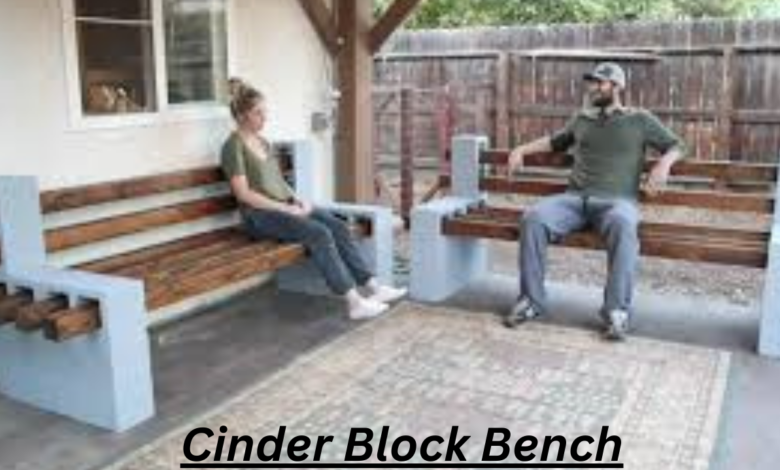Cinder Block Bench Maintenance Tips for Keeping Your Bench Looking Great

Are you looking for a stylish and sturdy addition to your outdoor space? A cinder block bench might just be the perfect choice. Not only does it provide ample seating, but its minimalist design can effortlessly blend into any garden or patio setting. However, like any piece of furniture, it requires some upkeep to maintain that fresh look and functional appeal. In this guide, we’ll explore essential tips for cinder block bench maintenance: tips for keeping your bench looking great throughout the seasons. Get ready to discover how simple care steps can ensure that your outdoor oasis remains inviting and beautiful!
Benefits of Using Cinder Blocks for Outdoor Furniture
Cinder blocks are a fantastic choice for outdoor furniture. They offer durability and strength that can withstand various weather conditions.
One significant advantage is their low cost. Cinder blocks are often more affordable than traditional materials, making them an excellent option for budget-conscious homeowners.
Their versatility is another perk. You can easily arrange cinder blocks to create benches, tables, or even decorative planters. The simple design allows for customization to fit any style.
Additionally, they provide stability. Unlike wooden furniture that may warp or rot over time, cinder block structures remain sturdy and reliable with minimal maintenance required.
They blend seamlessly into natural surroundings. Their neutral gray color complements gardens and patios effortlessly while providing an industrial-chic look that appeals to modern aesthetics.
Tips for Properly Maintaining Your Cinder Block Bench
To keep your cinder block bench in top shape, start with regular cleaning. A simple rinse with a hose can remove dirt and debris. For tougher stains, mix mild soap with water and scrub gently.
Next, consider protecting your bench from the elements. A water-resistant sealant will help guard against moisture damage. This is especially important if you live in a rainy area.
If you notice cracks or chips developing over time, don’t ignore them. Fill small cracks with concrete filler to prevent further deterioration. For larger issues, replacing damaged blocks might be necessary to maintain stability.
Periodic inspections are crucial for long-lasting maintenance. Check joints for wear and ensure that all blocks remain secure and level under weight. Keeping an eye on these details makes a significant difference in longevity.
- Cleaning and Removing Debris
Keeping your cinder block bench clean is essential for maintaining its appearance and longevity. Regular cleaning prevents mold, mildew, and dirt buildup that can detract from its aesthetic appeal.
Start by using a stiff-bristle brush to remove loose debris. This simple step often reveals the true color of your bench beneath layers of grime.
For tougher spots, mix warm water with mild detergent or vinegar. A sponge or cloth works well for this task; just avoid abrasive materials that could scratch the surface.
Rinse thoroughly with clean water after scrubbing to eliminate any soap residue. If possible, consider hosing down the bench occasionally to wash away more significant debris effortlessly.
Don’t forget about the area around your bench! Keeping surrounding spaces tidy not only enhances your outdoor setting but also protects your bench from additional dirt falling on it.
- Protecting from the Elements
To ensure your cinder block bench lasts, protection from the elements is crucial. Cinder blocks are sturdy but can be susceptible to moisture. Consider applying a waterproof sealant designed for masonry. This simple step can prevent water absorption and prolong its lifespan.
In addition to sealing, think about positioning your bench strategically. If possible, place it in a sheltered area—under a tree or an awning—to minimize direct exposure to rain and sun.
Using outdoor furniture covers during harsh weather also helps guard against fading and wear. These covers keep dust, debris, and moisture at bay when you’re not using the bench.
Don’t forget about temperature fluctuations; extreme conditions can lead to cracks over time. Regularly check for any signs of damage after storms or cold snaps so you can address issues promptly before they worsen.
- Repairing Cracks or Damage
Cracks or damage on your cinder block bench can happen over time, especially if it endures harsh weather conditions. It’s essential to address these issues promptly to maintain its aesthetic appeal and structural integrity.
For minor cracks, a simple solution is using concrete patching compound. Clean the area thoroughly before applying the compound with a putty knife. Smooth it out for an even finish.
If you encounter larger fissures, consider reinforcing them with metal brackets or additional blocks for support. This not only strengthens the structure but also adds an interesting design element.
Don’t forget about waterproof sealants once repairs are complete. These will help protect against moisture infiltration and extend the life of your bench significantly. Regular inspections allow you to catch any new damage early, ensuring that your outdoor seating remains inviting for years to come.
Creative Ways to Enhance and Decorate Your Cinder Block Bench
Transforming your cinder block bench can be a fun and creative project. Consider painting the blocks in vibrant colors or applying stencils for an artistic flair. This not only adds personality but also allows you to match your outdoor space.
Planting succulents or small flowers within the openings of the blocks brings life to your bench. It creates a beautiful focal point while blending nature with functionality.
Cushions are another fantastic addition. Select weather-resistant fabrics that provide comfort and style. Mix different patterns for a playful touch, making your seating more inviting.
You might even think about adding fairy lights along the back edge of the bench for enchanting evenings under the stars. The soft glow enhances ambiance without overwhelming your outdoor setting.
Consider using decorative pillows to bring in texture and color. They offer extra comfort while elevating aesthetics effortlessly.
Alternative Materials for Building Outdoor Benches
When considering materials for outdoor benches, cinder blocks are just one option. Wood remains a classic choice and offers natural beauty. Treated lumber can withstand the elements, while reclaimed wood adds character.
Metal is another excellent alternative. Aluminum or stainless steel frames provide durability and a modern aesthetic. They resist rust and corrosion, making them ideal for various climates.
Plastic composites have gained popularity too. These sturdy materials mimic wood but require far less maintenance. They come in various colors and designs, allowing for creative expression.
Stone is timeless as well—concrete slabs or granite offer impressive strength and elegance. For those looking to be eco-friendly, bamboo presents an innovative solution; it’s sustainable yet surprisingly durable when properly treated.
Choosing the right material ultimately depends on your style preferences and desired upkeep level. Each option brings its own charm to any outdoor space.
Conclusion: Enjoying Your Durable and Low-Maintenance Cinder Block Bench
Your cinder block bench is more than just a place to sit; it’s a testament to creativity and durability. With proper maintenance, you can ensure that it remains an attractive feature in your outdoor space for years to come. By keeping up with cleaning, protecting against the elements, and addressing any small repairs promptly, your bench will retain its appeal.
Feel free to personalize it with decorations or cushions that reflect your unique style. Remember that cinder blocks are versatile materials—you can always explore new designs or alternative furniture options down the line too.
Enjoy every moment spent on this low-maintenance seating solution while appreciating all the benefits it brings to your garden or patio area. With simple upkeep and a splash of creativity, you’ll find joy in having such an enduring piece of outdoor furniture at hand.



